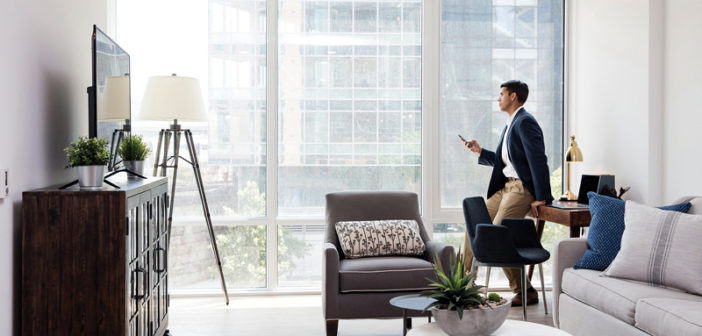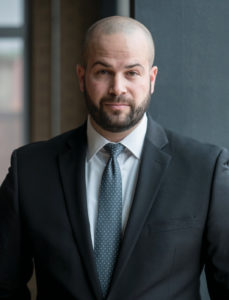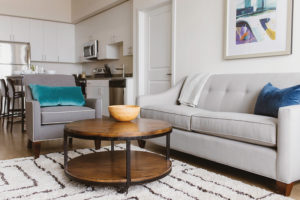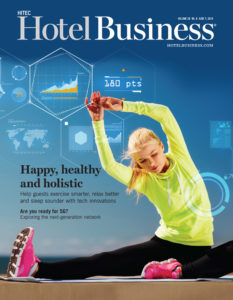WASHINGTON—Pop-up hotel company WhyHotel, in what it calls a natural progression, is opening an office on the West Coast and launching a new unit for the company, Hospitality Living.
While the company currently offers pop-up hotels in newly built, luxury apartment buildings during the lease-up phase, Hospitality Living will develop high-rise buildings specifically designed for the flexibility of hospitality or residential use.
“We always presumed that—and still do—the world is going to move to flexible assets where a stay exists on a spectrum—whether that is a long, 18-month unfurnished stay as a home or as a single night as a furnished apartment…and everything in the middle,” said Jason Fudin, CEO of WhyHotel. “When you have flexible assets that have a hospitality wrapper, you end up with more dynamic real estate. Our view has always been, and still is, that the best way to get there is making use of the most-underutilized asset ever, which is empty, brand-new apartments, and then working your way up to truly flexible assets in perpetuity, which we call Hospitality Living.”
A newly constructed building will allow for that flexibility. “We have the flexibility to do traditional multifamily assets on a temporary basis,” he said. “From a zoning standpoint, that is really important because we don’t remove housing stock. But in order to build new commercial hospitality assets, we have to do them from the ground up—to both provide a higher level of experience, one that has been purpose-built for our guests and our residents, and to have an asset that can be flexible over the next 70 years, so it is not beholden to one asset class. If the world needs more short, furnished stays or corporate housing, we can be that. If the world needs more long-term homes, we can be that. It allows us to have a dynamic asset instead of a single-use asset.”
The new buildings will have areas that fit both the residential and hospitality guest. They will focus on three component parts, according to Fudin.
One is the common areas. “The common areas in a traditional multifamily building today are designed to be passive for the most part, so you have large, beautiful spaces that go unused during the day from 8 a.m. to 5 p.m., and are underutilized generally,” he said. “The way we think about common spaces is you wrap them in activating uses and daytime uses—like coffee shops, bars, rentable conference rooms or co-working-type space. In a multifamily building today, that does not exist. What that allows you to do from an experience standpoint is to have what you have in well-built hotels: an activated common area.”
The next is flexible guest units. “Today’s units are built to be a home, so the insides of the units are not flexible; there aren’t flexible walls or flexible furniture to allow it to be lived in and to be used multiple ways,” said Fudin. “Those are all things that will be added into these purpose-built buildings.”
Service is the final component. “A multifamily building today is designed to have minimal engagement between property management and residents, where a hotel is pretty high touch,” he said. “There are certain things in the building you need to operate a more high-touch, hospitality experience—think about laundry, service areas and service elevators. Those are all things that will be designed in to facilitate that hospitality wrapper.”
The executive team for Hospitality Living is being built around Will Hu, the company’s new SVP of acquisitions and development, who is based in San Francisco, where the new West Coast office is located. “We will be mounting projects on the West Coast shortly, so opening a San Francisco office allows us to have a base of operations on the West Coast, somewhat proximate to other U.S. cities nearby,” said Fudin.
Joining Hu as the company’s new additions are Miguel Oliveira as chief marketing officer and Rohit Anand as experience visioneer. “[Anand] ran an architecture shop that did multifamily work for a few decades,” said Fudin. “He is seen in the multifamily space as one of the leaders of the future of design. If you talk to him about what design is, he will tell you less about how thick a wall is or where a door should be located, and more about how people physically experience space. As humans, we spend 90% of our time in the built environment. Rohit’s role with us is to really think about, as we launch these purpose-based assets, the experience for the guests and the residents. His role in our company is to take the lessons learned over three decades in the multifamily space, which has started to move toward the hospitality space, and make sure that it plays out in our physical building.”
He said that it will take three years before the first building under Hospitality Living will be opened. Until that happens, the company will continue to build its roster of pop-up properties. “Real estate is still built by hand, so it is going to take us a while to get there,” he said. “In the meantime, we are going to continue to grow our footprint of pop-up hotels nationally so that we have a set of customers and experiences, and we will add ancillary things to that which naturally parlay themselves into these purpose-built buildings.”
Next up? WhyHotel’s first pop-up outside of the East Coast in Houston. It is being launched in partnership with Camden Property Trust and is scheduled to begin accepting its first guests in late 2019, with the pop-up hotel running through late 2020.
The pop-up will include approximately 100 units at Camden Downtown, a 21-story, 271-unit residential high-rise located next to the Toyota Center and less than one mile from the George R. Brown Convention Center.
Fudin said, “The pop-up side of our business, though early, is still about to get significantly larger and will be the majority of our business near-term; this really represents laying the seeds for a revolutionary change in the physical asset with Hospitality Living, so we are still very much a pop-up hotel company and will continue to be that in a large way. But, this is an important first step toward moving toward assets that are designed better.”
The success of the original pop-up concept fueled the next step in the company’s expansion. “Things have gone exceptionally well, which is obviously why we are doubling down,” said Fudin. “We think about the success of our business in terms of three groups of people. One is the real estate owner and how they feel about us being in the building. They have been exceptional for us on the reference side and have been very happy with the outcome. The next is the residents of the building. In DC, in the first 90 days, more than one-third of them used us as an amenity, which we see as a huge win. The last and most important, we think about our guest. The guest reviews have been exceptional. We sit on the review portals at a similar rating as a Four Seasons, even though we are not high-level service. We are more like a self-directed stay. All three parts of that business have gone really well for us—that is why we are doubling down.” HB




